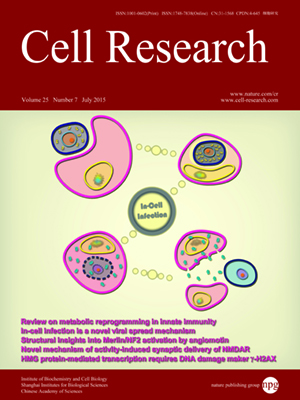
Volume 25, No 7, Jul 2015
ISSN: 1001-0602
EISSN: 1748-7838 2018
impact factor 17.848*
(Clarivate Analytics, 2019)
Volume 25 Issue 7, July 2015: 785-800 | Open Access
ORIGINAL ARTICLES
In-cell infection: a novel pathway for Epstein-Barr virus infection mediated by cell-in-cell structures
Chao Ni1,*, Yuhui Chen1,*, Musheng Zeng2,*, Rongjuan Pei3, Yong Du2, Linquan Tang2, Mengyi Wang4, Yazhuo Hu1, Hanyu Zhu1, Meifang He1, Xiawei Wei5, Shan Wang6, Xiangkai Ning7, Manna Wang7, Jufang Wang1, Li Ma8, Xinwen Chen3, Qiang Sun7, Hong Tang3, Ying Wang9 and Xiaoning Wang1
1Institute of Life Sciences, Chinese PLA General Hospital and School of Bioscience and Bioengineering, South China University of Technology, Key Laboratory of Normal aging and Geriatric & the State Key Laboratory of Kidney, Beijing 100853 & the Provincial Key Laboratory of Biotechnology, Guangdong 510006, China
2State Key Laboratory of Oncology in Southern China, Sun Yat-Sen University Cancer Center, Guangzhou, Guangdong 510060, China
3Wuhan Institute of Virology, Chinese Academy of Sciences, Wuhan, Hubei 430071, China
4School of Ophthalmology and Optometry, Wenzhou Medical University, Wenzhou, Zhejiang 325000, China
5State Key Laboratory of Biotherapy, West China Hospital, Sichuan University, Chengdu, Sichuan 610041, China
6The Second Affiliated Hospital, Guangzhou Medical University, Guangzhou, Guangdong 510260, China
7Laboratory of Cell Engineering, Institute of Biotechnology, Beijing 100071, China
8Institute of Molecular Immunology, School of Biotechnology, Southern Medical University, Guangzhou, Guangdong 510515, China
9Department of Immunology and Microbiology, Shanghai Institute of Immunology, Shanghai Jiaotong University School of Medicine, Shanghai 200025, China
Correspondence: Xiaoning Wang;Ying Wang(xnwang88@163.com;ywang@sibs.ac.cn)
Epstein-Barr virus (EBV) can infect both susceptible B lymphocytes and non-susceptible epithelial cells (ECs). Viral tropism analyses have revealed two intriguing means of EBV infection, either by a receptor-mediated infection of B cells or by a cell-to-cell contact-mediated infection of non-susceptible ECs. Herein, we report a novel “in-cell infection” mechanism for EBV infection of non-susceptible ECs through the formation of cell-in-cell structures. Epithelial CNE-2 cells were invaded by EBV-infected Akata B cells to form cell-in-cell structures in vitro. Such unique cellular structures could be readily observed in the specimens of nasopharyngeal carcinoma. Importantly, the formation of cell-in-cell structures led to the autonomous activation of EBV within Akata cells and subsequent viral transmission to CNE-2 cells, as evidenced by the expression of viral genes and the presence of virion particles in CNE-2 cells. Significantly, EBV generated from in-cell infected ECs displayed altered tropism with higher infection efficacy to both B cells and ECs. In addition to CNE-2 tumor cells, cell-in-cell structure formation could also mediate EBV infection of NPEC1-Bmi1 cells, an immortalized nasopharyngeal epithelial cell line. Furthermore, efficient infection by this mechanism involved the activation of the PI3K/AKT signaling pathway. Thus, our study identified “in-cell infection” as a novel mechanism for EBV infection. Given the diversity of virus-infected cells and the prevalence of cell-in-cell structures during chronic infection, we speculate that “in-cell infection” is likely a general mechanism for EBV and other viruses to infect non-susceptible ECs.
10.1038/cr.2015.50
FULL TEXT | PDF
Browse 2456


